KOREAN STORIES FOR LANGUAGE LEARNERS JULIE DAMRON, Ph.D.
&
EUNSUN YOU, MA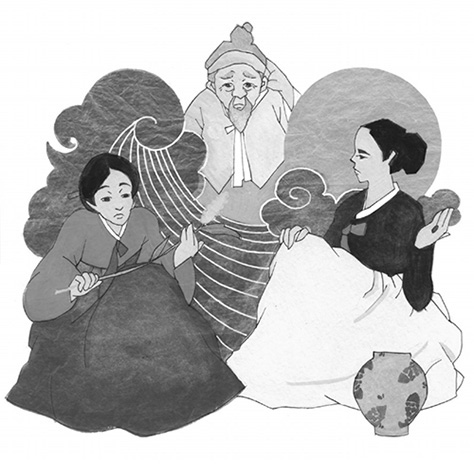
 Preface As a university professor of Korean for many years, I have used numerous books with many different types of students. I have found lots of good Korean grammar books and online programs to use in my courses. Unfortunately, I struggled to find a reading book for true beginners. I wanted to use Korean stories in my classes so that we could discuss the culture that went along with the stories, but every Korean storybook reader that I found was for intermediate level or above. Although the authors claimed it was for beginners, none of them were appropriate for true beginner students. The passages were long, the sentence structures were advanced and the vocabulary was large and complicated.
Preface As a university professor of Korean for many years, I have used numerous books with many different types of students. I have found lots of good Korean grammar books and online programs to use in my courses. Unfortunately, I struggled to find a reading book for true beginners. I wanted to use Korean stories in my classes so that we could discuss the culture that went along with the stories, but every Korean storybook reader that I found was for intermediate level or above. Although the authors claimed it was for beginners, none of them were appropriate for true beginner students. The passages were long, the sentence structures were advanced and the vocabulary was large and complicated.
My beginning students asked for level-appropriate material to read in Korean because they felt passionate about reading beyond the functional text presented in their grammar books. It was for them that I started writing this beginning Korean reader. Korean Stories for Language Learners can be used either by an individual who wants to learn to read and write in Korean or by an instructor in the Korean classroom. Chapters are self-contained and easy to follow. Instructions are in both English and Korean. The early stories in this book are highly modified from their original version.
They become increasingly less modified in later chapters. All chapters have vocabulary words written in Korean, Romanized Korean and in English. Each chapter contains the story written in Korean and pre- and post-reading activities. The book also contains extensive Korean and English glossaries. At the end of this book a basic explanation of the sounds of Korean (vowels and consonants) is given. This instructs the reader on how to read and write those vowels, consonants and then syllables.
The book provides plenty of writing practice for Korean letters before moving on to writing words. There is a helpful pronunciation activity that helps students distinguish between aspirated, tense and lax sounds. Finally, students learn to practice writing basic sentences. I would like to acknowledge You Eunsun, my graduate student assistant and co-author. EunSun worked tirelessly to help find and modify the Korean folktales used in this book, all while taking courses in her masters program, teaching Korean and studying for her preliminary examination. She was an amazing asset to this work.
I also want to thank my upper-level undergraduate students who edited various versions of this book, and my Korean 101 and 102 students who love studying Korean and whose avid passion for the language and culture prompted me to begin writing this book. Thanks to Nancy Goh at Tuttle Publishing, to Megan Young who did the majority of the illustrations and to Kim Kyuri for the audio recordings. Finally, I want to thank my supportive husband, Danny, and my loving kids, Leah, Andrew and Maya, who are the joy of my life. Julie Damron A Brief Introduction to the Korean Language ! Annyeonghaseyo! Welcome to Korean Stories for Language Learners! This book is designed to help you, a new learner of Korean, establish a foundation in the Korean language and develop a basic cultural understanding that you can then build on for years to come. No matter why youve decided to start learning Korean, you are in the right place! After learning to read and write in the first few chapters, you will begin building vocabulary by reading Korean folktales and applying this new knowledge as you begin speaking and writing. As you read, you will not only begin using the language, you will also begin to understand the history of Korean culture.
In most countriesespecially in a country as old as Koreathe language is closely tied to the culture and vice versa. Learning to appreciate the uniqueness of Korea will help you cultivate a passion for the language as you continue learning. It is often said that a foreigner will never learn to speak Korean well until they learn to love kimchi! You will find that as you build this passion for the people, culture, and history, you will discover a greater motivation to study. Look for ways to use the language as often as you can! Understanding Korea Before we dive into the fundamentals of the language, lets take a look at Korea as a whole. Korea is a beautiful country with a history seemingly as old as time. Today, the country is divided into the North and South: the Democratic Peoples Republic of Korea in the north and the Republic of Korea to the south.
Although the governments of these two countries are often at odds, the majority of native Koreans dream of the day when their country will be unified once again. Since the end of the Korean War in 1953, both countries have experienced remarkable net growth, although since the 1970s South Korea has dramatically outpaced growth in the North. Economic prosperity in South Korea has resulted in large population growth and the development of huge urban centers like Seoul and Busan. In 1942, toward the end of Japanese rule, the population of Korea was around 25 million. Today, 51 million Koreans live in South Korea and about 25 million live in the North. If one includes Koreans living internationally, nearly 80 million people are native speakers of Korean.
This makes it one of the most commonly spoken languages in the world. Beginning in the 1990s, a growing awareness of and interest in the South Korean culture has led to an increase in collective international interest in learning Korean. This expanding sphere of influence held by Korean culture has been termed the Korean Wave (or hanryu ), due in part to its sudden expansion. While the main catalyst for the spread of South Korean culture was originally the novelty of and interest in K-dramas and K-pop, Koreas history and traditional culture are beginning to receive international recognition as South Korea continues developing into a travel destination for local Asian tourists and others alike. Seoul, the largest city on the Korean peninsula and capital of South Korea, is home to around 25 million people. In other words, one out of every three Koreans lives in Seoul! Because the area around Seoul was settled over 6,000 years ago, serving as the capital for various kingdoms and empires throughout its history, the city of Seoul has developed into a thriving metropolis that blends traditional Korean culture with the advances of modernity.
This unique atmosphere attracts millions of tourists every year, allowing foreigners to come and experience the Korean way. These millions of tourists have added a new component to the idea of the Korean Wave, as chefs and internationally minded visitors have returned to their countries with a craving for Korean cooking. The idea of fusion food, or the combining of two foods from different countries, is nothing new, and South Koreas rise has given way to dishes like the bulgogi burger and the kimchi burrito as restaurants have begun experimenting with the strong flavors unique to Korea. Understanding the Korean culture is crucial to developing a strong ability with the language, and there is no way to become more accustomed to the Korean culture than by learning to love the food. The traditional Korean diet revolves around rice, vegetables, kimchi, banchan (assorted side dishes), and a hot pepper paste called gochujang (). Even though fast food and other western foods have nearly taken over the diet of younger Koreans, traditional components remain central to the modern Korean diet.
One reason the Korean culture is so closely tied to food is because of the traditions associated both with food preparation, and the seasons food is eaten. In November of each year, the country begins an enormous project called Kimjang ().
Next page
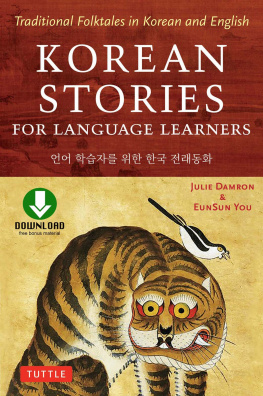
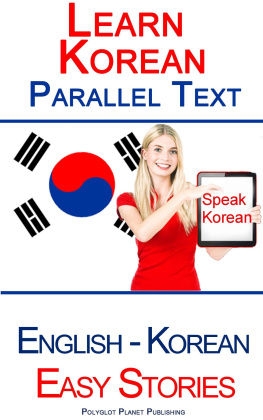
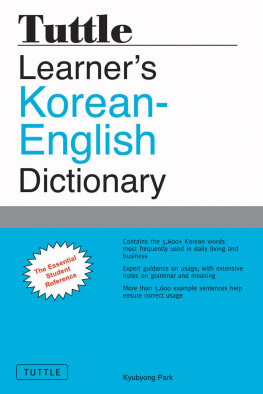
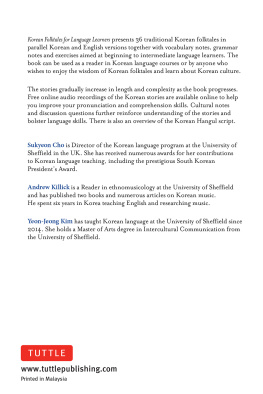
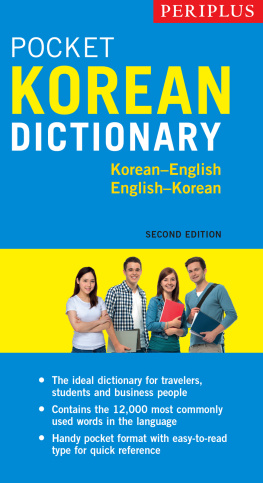
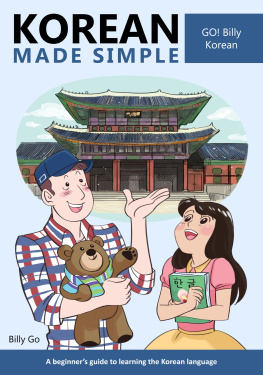
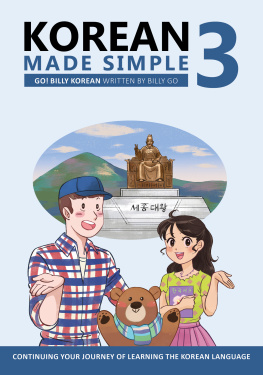

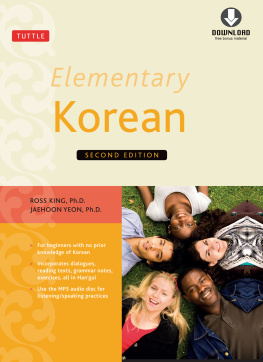
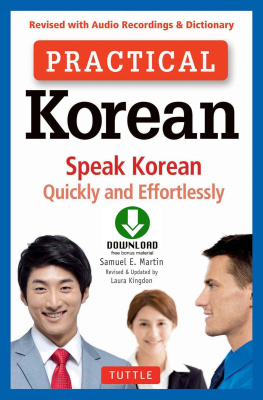
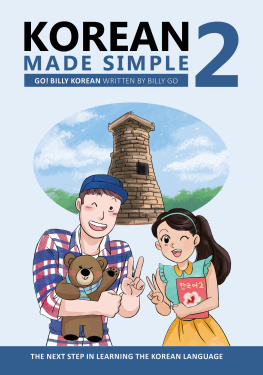

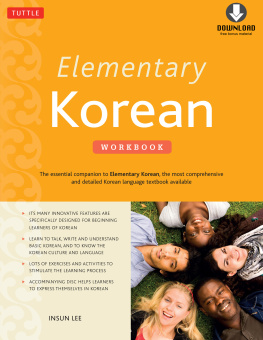

 Preface As a university professor of Korean for many years, I have used numerous books with many different types of students. I have found lots of good Korean grammar books and online programs to use in my courses. Unfortunately, I struggled to find a reading book for true beginners. I wanted to use Korean stories in my classes so that we could discuss the culture that went along with the stories, but every Korean storybook reader that I found was for intermediate level or above. Although the authors claimed it was for beginners, none of them were appropriate for true beginner students. The passages were long, the sentence structures were advanced and the vocabulary was large and complicated.
Preface As a university professor of Korean for many years, I have used numerous books with many different types of students. I have found lots of good Korean grammar books and online programs to use in my courses. Unfortunately, I struggled to find a reading book for true beginners. I wanted to use Korean stories in my classes so that we could discuss the culture that went along with the stories, but every Korean storybook reader that I found was for intermediate level or above. Although the authors claimed it was for beginners, none of them were appropriate for true beginner students. The passages were long, the sentence structures were advanced and the vocabulary was large and complicated.